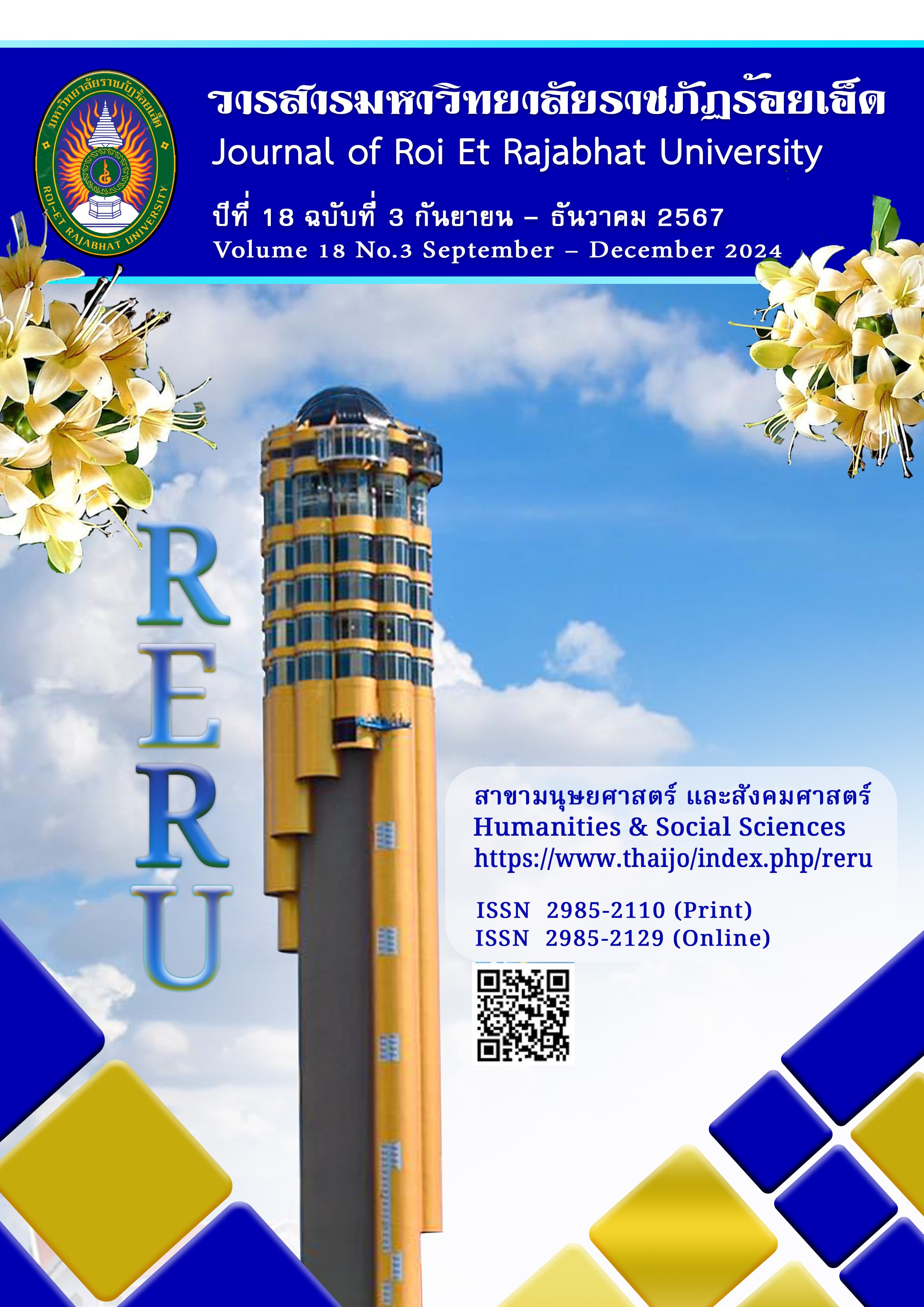Employment Models for Elderly Workers in the Private Sector to Support Smart City Development in Roi Et Province, Thailand
Keywords:
The elderly, Elderly employment, Smart cityAbstract
The article presents a research project entitled “Employment Models for Elderly Workers in the Private Sector to Support Smart City Development in Roi Et Province, Thailand” which aimed to study the demand for elderly workers in the private sector, to examine the challenges and obstacles of hiring elderly workers, and to explore employment models for elderly workers to support the smart city development in Roi Et Province. This qualitative research obtained 43 key informants through purposive sampling. Data collection employed in-depth interviews and focus group discussions. The data was analyzed using content analysis and presented through descriptive analysis.
The research results revealed that: 1) The demand for elderly workers in the private sector mostly covered their experience, skills, knowledge, and a sense of attachment to their work, 2) Challenges in hiring elderly workers included a lack of comprehensive laws addressing their welfare, and 3) Proposed employment models for elderly workers to support the smart city development highlighted the following key points. 3.1) Clear policies and plans should be implemented to support the employment of elderly workers. 3.2) The retirement age should not be extended automatically, but it should be based on the nature of the job and the individual’s physical and mental readiness. However, if future labor shortages arise, an extension of up to 65-70 years may be necessary with clear regulations. 3.3) Elderly workers should develop digital and technological skills. 3.4) Government agencies should support elderly employment through relevant policies or legislation.
References
กาณติมา พงษ์นัยรัตน์. (2564). แนวทางในการจ้างแรงงานผู้สูงวัยของภาคเอกชนเพื่อรองรับโครงการพัฒนาเศรษฐกิจพิเศษภาคตะวันออก. ชลบุรี: คณะรัฐศาสตร์และนิติศาสตร์ มหาวิทยาลัยบูรพา.
แก้วขวัญ ตั้งติพงศ์กูล. (2562). การขยายโอกาสการจ้างงานผู้สูงวัยภาคเอกชนในประเทศไทย. เศรษฐสาร. สืบค้นเมื่อ 4 มกราคม 2567, จาก https://setthasarn.econ.tu.ac.th/blog/detail/20
พัชรพงศ์ ชวนชม, ธีระวัฒน์ จันทึก และพิทักษ์ ศิริวงศ์. (2561). ลักษณะงานที่เหมาะสมกับแรงงานผู้สูงอายุ.วารสารวิจัยและพัฒนา วไลยอลงกรณ์ในพระบรมราชูปถัมภ์, 13(1), 107-116.
มหาวิทยาลัยสุโขทัยธรรมาธิราช. (2557). นิยาม: สังคมผู้สูงวัย. สืบค้นเมื่อ 4 มกราคม 2567, จาก http://www.stou.ac.th/stouonline/lom/data/sec/Lom12/05-01.html
มูลนิธิสถาบันวิจัยและพัฒนาผู้สูงอายุไทย. (2563). สถานการณ์ผู้สูงอายุไทย พ.ศ. 2563. กรุงเทพฯ: มูลนิธิสถาบันวิจัยและพัฒนาผู้สูงอายุไทย.
ศูนย์ข้อมูลทางสังคมจังหวัดร้อยเอ็ด. (2567). สถานการณ์ทางสังคมจังหวัดร้อยเอ็ด ประจำปี 2567 : สถานการณ์ผู้สูงวัย. ร้อยเอ็ด: สำนักงานพัฒนาสังคมและความมั่นคงของมนุษย์จังหวัดร้อยเอ็ด.
สถาบันวิจัยประชากรและสังคม มหาวิทยาลัยมหิดล. (2558). สถานการณ์ผู้สูงวัยไทย พ.ศ. 2557. กรุงเทพฯ: อัมรินทร์พริ้นติ้ง แอนด์พับลิชชิ่ง.
สุวรรณี สิงห์ฤาเดช. (2563). เมืองอัจฉริยะ (Smart City) ต้องมีเทคโนโลยีสำคัญอะไรบ้าง?. สืบค้นเมื่อ 4 มกราคม 2567, จาก https://www.greennetworkthailand.com/เมืองอัจฉริยะ-smart-city
สำนักงานประชาสัมพันธ์จังหวัดร้อยเอ็ด. (2567). ร้อยเอ็ดหารือการจัดทำข้อเสนอเพื่อขอรับการพิจารณาการเป็นเมืองอัจฉริยะ “ร้อยเอ็ดเมืองอัจฉริยะ Smart City”. สืบค้นเมื่อ 14 ธันวาคม 2566, จาก https://roiet.prd.go.th/th/content/category/detail/id/877/iid/318177
สำนักงานประชาสัมพันธ์จังหวัดร้อยเอ็ด. (2567). จังหวัดร้อยเอ็ดร่วมกับ DEPA -ขับเคลื่อนโครงการเมืองอัจฉริยะร้อยเอ็ด ยกระดับคุณภาพชีวิตของประชาชนและพัฒนาร้อยเอ็ดให้ก้าวทันเทคโนโลยี. สืบค้นเมื่อ 14 ธันวาคม 2566, จาก https://roiet.prd.go.th/th/content/category/detail/id/877/iid/310063
สำนักงานส่งเสริมเศรษฐกิจดิจิทัล. (2567). การส่งเสริมเมืองอัจฉริยะ. สืบค้นเมื่อ 9 พฤศจิกายน 2567,
จาก https://www.depa.or.th/th/smart-city-plan/existing-smart-city
Camero, S.A. and Albamart, E. (2019). City and information technology. A review. Retrieved Jan 25, 2024, From https://smartcitycluster.org/wp-content/uploads/2021/03/smart-city-and-it-review-2019.pdf
ITU. (2022). The United for Smart Sustainable Cities. Retrieved Jan 25, 2024, From https://u4ssc.itu.int/
Morozov, E. and Bria, F. (2018). Rethinking the Smart City Democratizing Urban Technology. Retrieved Jan 25, 2024, From ttps://onlineopen.org/media/article/583/open_essay_2018_morozov_rethinking.pdf
United Nations. (2015). World population ageing 2015. New York: United Nations.
UN-Habitat. (2020). People-Centered Smart Cities. Retrieved Jan 3, 2024,
From https://unhabitat.org/programme/people-centered-smart-cities
Yigitcanlar, T. and Lee, S. H. (2014). Korean ubiquitous-eco-city: A smart-sustainable urban form or a branding hoax?. Technological Forecasting & Social Change, 89, 100 –114.
Downloads
Published
How to Cite
Issue
Section
License
Copyright (c) 2024 Roi Et Rajabhat University

This work is licensed under a Creative Commons Attribution-NonCommercial-NoDerivatives 4.0 International License.
บทความที่ได้รับการตีพิมพ์เป็นลิขสิทธิ์ของวารสารมหาวิทยาลัยราชภัฎร้อยเอ็ด
ข้อความที่ปรากฏในบทความแต่ละเรื่องในวารสารวิชาการเล่มนี้เป็นความคิดเห็นส่วนตัวของผู้เขียนแต่ละท่านไม่เกี่ยวข้องกับมหาวิทยาลัยราชภัฎร้อยเอ็ด และคณาจารย์ท่านอื่นๆในมหาวิทยาลัยฯ แต่อย่างใด ความรับผิดชอบองค์ประกอบทั้งหมดของบทความแต่ละเรื่องเป็นของผู้เขียนแต่ละท่าน หากมีความผิดพลาดใดๆ ผู้เขียนแต่ละท่านจะรับผิดชอบบทความของตนเองแต่ผู้เดียว





